State TV provides few details about electrical problem; on Saturday, Rouhani inaugurated cascades of IR-6s and IR-5s at same plant, in open breach of nuclear deal
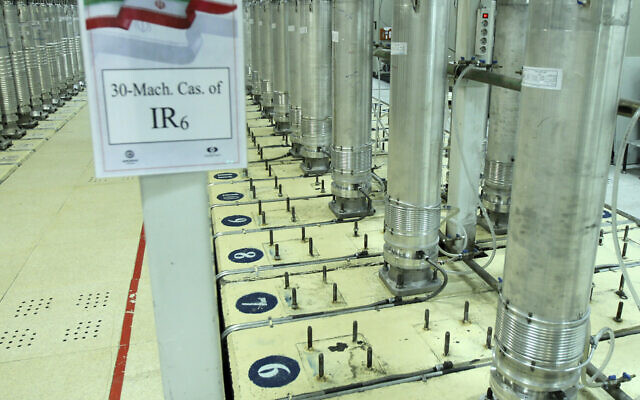
Centrifuge machines in the Natanz uranium enrichment facility in central Iran, in an image released on November 5, 2019. (Atomic Energy Organization of Iran via AP, File)
Iran’s Natanz nuclear site suffered a problem Sunday involving its electrical distribution grid just hours after starting up new advanced centrifuges that more quickly enrich uranium, state TV reported.
It was the latest incident to strike one of Tehran’s most-secured sites amid negotiations over the tattered atomic accord with world powers.
State TV quoted Behrouz Kamalvandi, a spokesman for the Atomic Energy Organization of Iran (AEOI), announcing the incident.
Kamalvandi said there were no injuries or pollution caused by the incident.
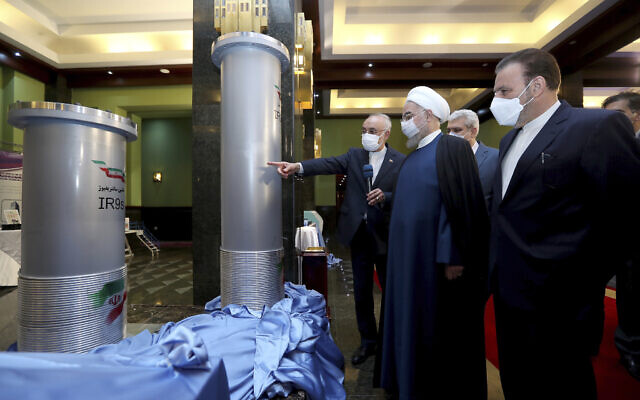
In this photo released by the official website of the office of the Iranian Presidency, President Hassan Rouhani, second right, listens to head of the Atomic Energy Organization of Iran Ali Akbar Salehi while visiting an exhibition of Iran’s new nuclear achievements in Tehran, Iran, April 10, 2021. (Iranian Presidency Office via AP)
The word state television used in its report attributed to Kamalvandi in Farsi can be used for both “accident” and “incident.” It didn’t immediately clarify the report, which ran at the bottom of its screen on its live broadcast.
The AEOI did not immediately issue a formal statement about the incident on its website.
Israel has been blamed for an attack on an advanced centrifuge development and assembly plant at Natanz in July. It has also been blamed, together with the US, for the Stuxnet virus that sabotaged Iranian enrichment centrifuges a decade ago.
Tehran and Jerusalem are currently believed to be engaged in a maritime shadow war, with both sides blaming the other for explosions on vessels.
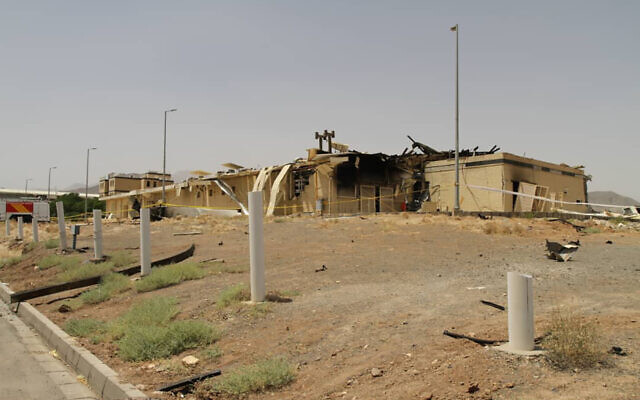
A building Iran claims was damaged by a fire at the Natanz uranium enrichment facility some 200 miles (322 kilometers) south of Tehran, on July 2, 2020. (Atomic Energy Organization of Iran via AP)
Amid rising tensions in the region surrounding Iran’s nuclear activities and a possible revival of the 2015 nuclear accord, a deal Prime Minister Benjamin Netanyahu has vehemently opposed, US Defense Secretary Lloyd Austin will arrive in Israel on Sunday for talks with senior officials.
Iran announced on Saturday that it had started up advanced IR-6 and IR-5 centrifuges that enrich uranium more quickly, in a new breach of its undertakings under the troubled 2015 nuclear agreement.
It also said it has begun mechanical tests on an even faster nuclear centrifuge: The output of Iran’s IR-9 centrifuge, when operational, would be 50 times quicker than the first Iranian centrifuge, the IR-1, which is the only one that the 2015 deal allows it to use. Iran’s nuclear program is also developing IR-8 centrifuges.
On Friday night, Kamalvandi said the country was enriching material at a rapid pace — in violation of the nuclear deal — adding that should “Western parties” continue to delay the lifting of sanctions, they would be the “big loser.”
“The number of our centrifuges and the amount of enriched (nuclear) material are increasing rapidly,” said Behrouz Kamalvandi in comments broadcast on Instagram and cited by the Tasnim news agency Saturday.
On Friday, the International Atomic Energy Agency (IAEA) said in a report that Iran had again violated limits on its stockpile of enriched uranium, according to Reuters.
The IAEA report does not explicitly say that Iran violated the deal’s terms, but the agency releases such reports when a breach occurs. Diplomatic sources told Reuters that the report indicated that a breach of the deal had occurred.
The 2015 deal placed strict limits on Iran’s uranium stockpile. The IAEA determined on Wednesday that Iran had violated those limits by recovering uranium from items called scrap fuel plates.
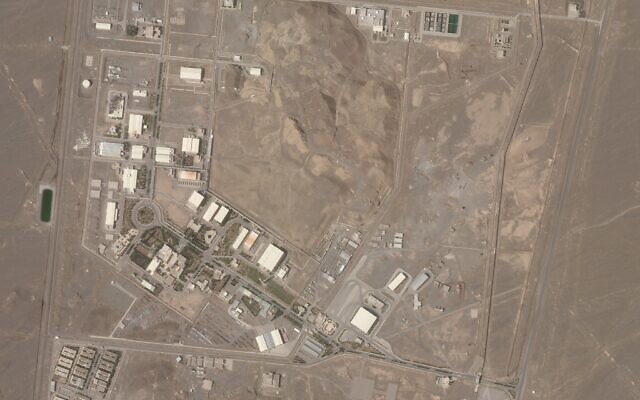
This satellite photo from Planet Labs Inc. shows Iran’s Natanz nuclear facility on April 7, 2021 (Planet Labs Inc. via AP)
Iran met with the deal’s signatories in Vienna last week. The talks broke Friday, with no clear signs of progress.
The US said it had offered “very serious” ideas on reviving the nuclear accord but was waiting for Tehran to reciprocate.
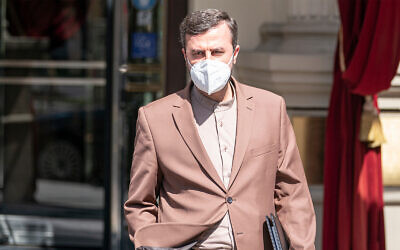
Iran’s Governor to the International Atomic Energy Agency (IAEA), Kazem Gharib Abadi, leaves the ‘Grand Hotel Wien’ where closed-door nuclear talks with Iran are taking place in Vienna, Austria, April 9, 2021. (AP Photo/Florian Schroetter)
US President Joe Biden hopes to return to the 2015 agreement, which his predecessor Donald Trump had trashed as he launched a “maximum pressure” campaign in hopes of bringing Tehran to its knees.
Biden argues that the 2015 nuclear deal negotiated under former president Barack Obama had been successful, with UN inspectors saying Iran was meeting its promises to scale back nuclear work dramatically.
Iran has demanded that the United States first lift all sanctions imposed by Trump, which include a sweeping unilateral ban on its oil exports, before it falls back in line with obligations it suspended.
The “US —- which caused this crisis —- should return to full compliance first,” Iranian Foreign Minister Mohammad Javad Zarif wrote on Twitter, adding that “Iran will reciprocate following rapid verification.”
Talks are set to resume Wednesday with Iran again meeting the other nations in the deal — Britain, China, France, Germany and Russia as well as the European Union.



World class instigators … may the Iranians fail…
That is great news – may there be many such “accidents” to frustrate Amalek!